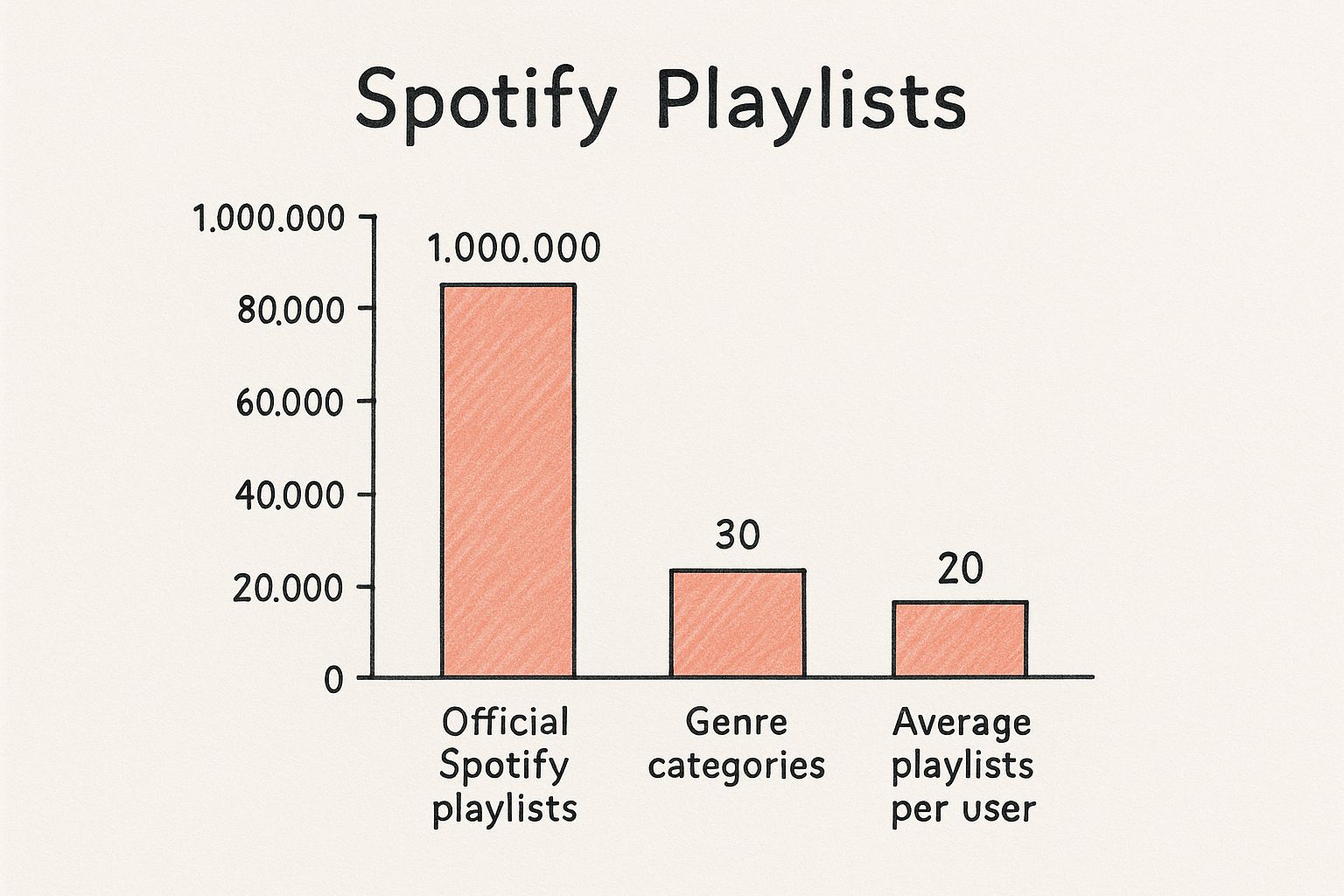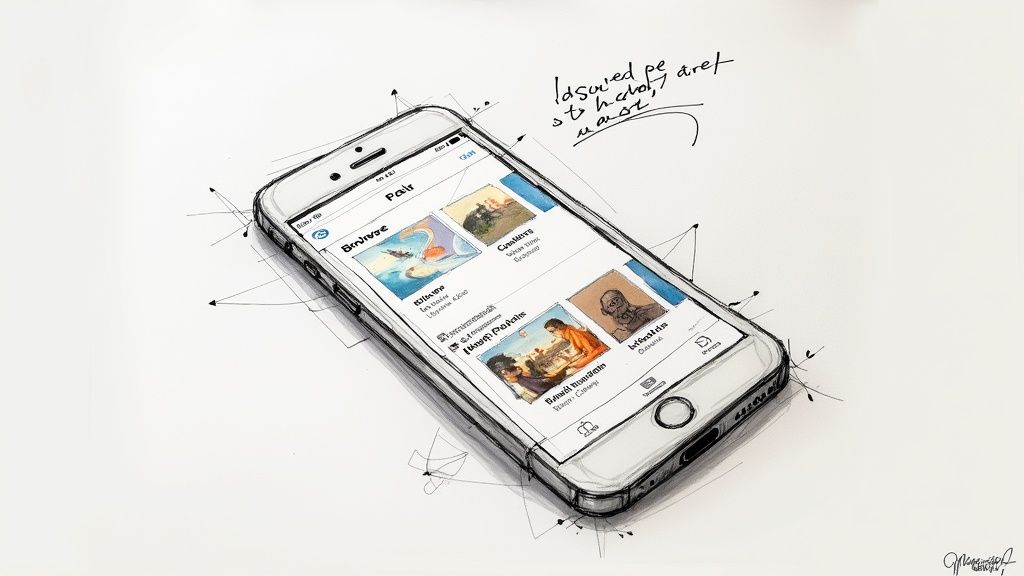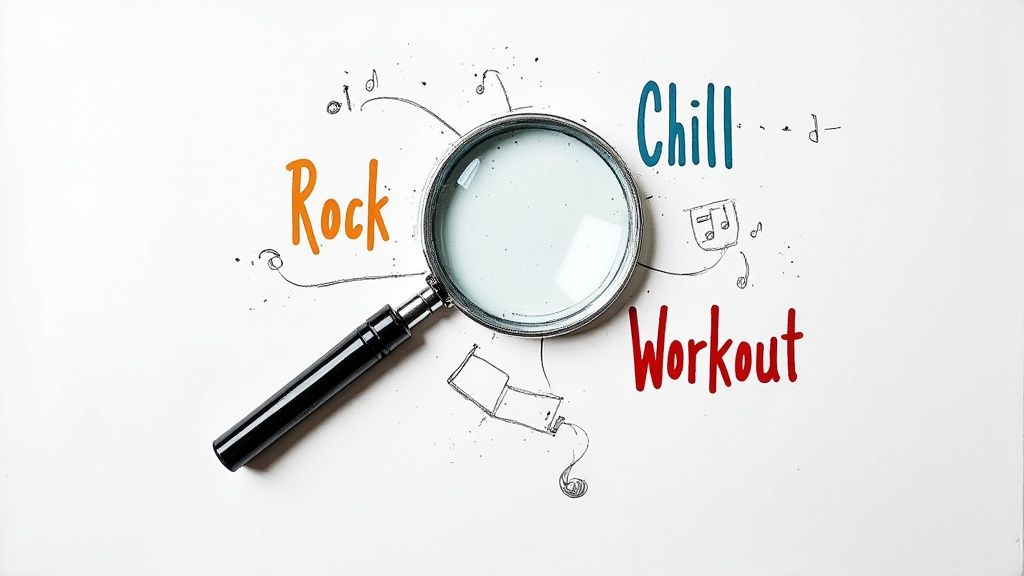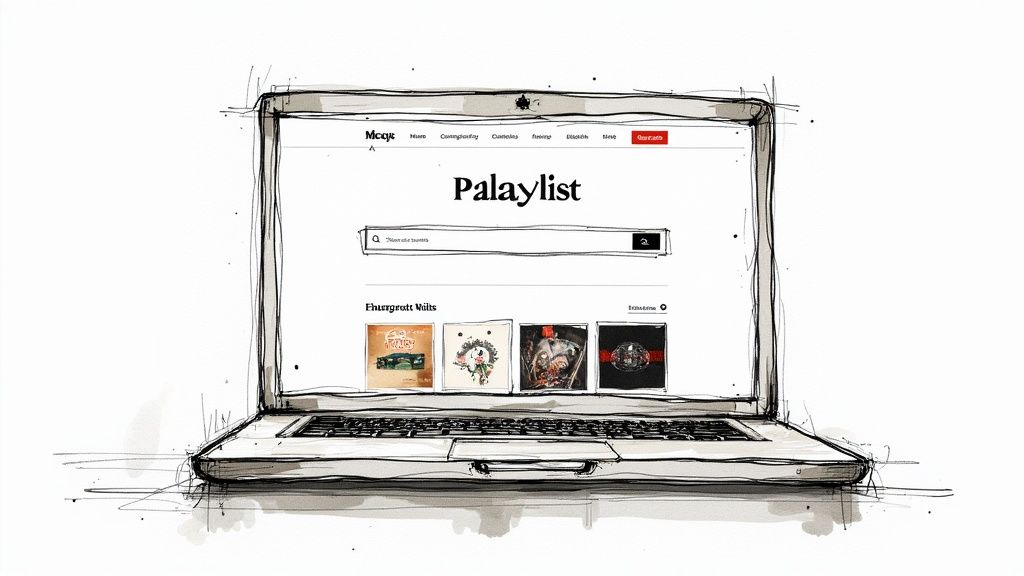How to Find Spotify Playlists for New Music
- Lars Ystrøm
- Jul 14
- 10 min read
Finding great playlists on Spotify can feel like a chore, but it often boils down to mastering the platform's own powerful, built-in tools. You can get way more out of it than just basic searches by using advanced modifiers and really digging into your personalized 'Made For You' section. This is how you uncover music that truly fits your vibe.
Your Starting Point for Playlist Discovery
Let's get practical. The easiest place to kick things off is right inside the Spotify app itself.
Most people just type a genre like "Chill Lo-fi" and click the first result. That's fine, but you can get much better, more targeted results by being more specific. Try searching for moods, activities, or even niche aesthetics. Think "late night drive," "coding focus," or "cottagecore."
This simple shift in approach taps you into a massive ecosystem of both user-curated and official Spotify playlists. The scale of this environment is pretty staggering.

What this really shows is that while official playlists are great, the real gold is in the countless lists created by users like you for every imaginable scenario.
To help you get started, here's a quick reference for different ways you can search right within Spotify to find what you're looking for.
Effective Playlist Search Methods on Spotify
Search Method | Best For | Example |
|---|---|---|
Mood/Activity Search | Finding playlists for a specific vibe or task. | "rainy day indie" or "gym workout" |
Niche Genre Search | Uncovering hyper-specific subgenres and communities. | "dark academia classical" or "phonk" |
"Similar to" Search | Discovering artists and playlists related to your sound. | "similar to Tame Impala" |
Record Label Search | Finding playlists curated by specific indie or major labels. | "Sub Pop Records" or "Anjunabeats" |
Using a mix of these methods will give you a much richer set of playlists to explore than just sticking to broad genre terms.
Tapping Into Algorithmic Playlists
Beyond what you can manually search for, Spotify's algorithm is your most powerful ally. The 'Made For You' hub is your personal discovery engine, serving up playlists tailored specifically to what you listen to.
You're probably familiar with the big three:
Discover Weekly: Your Monday morning delivery of new artists and deep cuts, all based on what you’ve had on repeat.
Release Radar: Updated every Friday, this is your go-to for new music from artists you already follow or listen to a lot.
Daily Mixes: These are genre-based mixes that cleverly blend your favorite tracks with similar songs you haven't heard yet.
To really make these work for you, you have to "train" the algorithm. The more you listen, like songs, and add music to your own playlists, the smarter its recommendations get. And don't sleep on the "Hide song" feature—it's just as important for telling Spotify what you don't like.
Discover Weekly, in particular, has become a cornerstone of modern music discovery. It's responsible for a mind-boggling 56 million new artist discoveries every week. Even more impressive, 77% of those are for emerging artists, proving just how valuable this single playlist can be. If you're curious, you can read more about the impact of this legendary playlist and its key statistics.
Breaking Down Editorial vs. User-Generated Playlists
When you start digging into Spotify, you'll find two main kinds of playlists: the massive, official lists put together by Spotify's own team and the millions of hyper-specific ones made by everyday listeners. Knowing the difference is your first step to finding the perfect soundtrack for any moment, or the right home for your own music.

Editorial playlists are the big leagues. Think Today's Top Hits or RapCaviar. These are the billboards of Spotify, curated by an in-house team of music experts. They’re packed with major artists and the tracks that are blowing up right now. For an artist, landing on one of these is a career-defining moment. For a listener, they're the easiest way to keep a finger on the pulse of what's hot.
Then you have user-generated playlists, which are really the heart and soul of music discovery on the platform. These are handcrafted by fellow fans, influencers, and brands for literally any mood, vibe, or micro-genre you can imagine. We're talking about lists like "90s Alternative Road Trip" or "Mellow Beats for Deep Focus." They often have a much more personal, authentic feel because they’re made by people who are genuinely passionate about that specific sound.
How to Actually Judge a Playlist
Before you smash that "follow" button, it pays to do a little homework. A big follower count looks impressive, but it’s definitely not the full picture.
Here's what I look for:
Check the "Last Updated" Date: Is the playlist getting regular love? An actively managed list means fresh music and a curator who cares. If it hasn't been touched in six months, it's probably stale.
Listen to the Flow: Does the playlist actually make sense? A great curator creates a seamless listening experience where each song transitions smoothly into the next, holding a consistent mood. It shouldn't feel like a random jumble of tracks.
Read the Description: Good curators often use the description to set the scene, explaining the playlist's purpose. This little bit of text can tell you a lot about the vibe they're going for.
Here's a pro tip: A playlist's true value is in its engagement. A list with 5,000 dedicated, daily listeners is way more impactful than one with 50,000 passive followers who never even press play.
This is especially true for playlists focused on new music. In fact, 70% of the top 20 most followed playlists on Spotify are built around recent releases. Giants like Today’s Top Hits pull in tens of millions of followers hungry for what's next. Understanding this trend helps you zero in on playlists that have real influence.
Ultimately, both editorial and user-created lists are goldmines. For artists, getting placed on them is a non-negotiable part of growing your fanbase, and our guide on how to get more listeners on Spotify dives much deeper into those strategies. For listeners, they are your ticket to discovering a universe of sound you never knew existed.
Using Third-Party Tools to Find Hidden Gems
While searching inside the Spotify app is your starting point, the real secret weapons used by industry pros are dedicated third-party platforms. These tools are what separate a hopeful guess from a data-driven strategy.
Think of it like this: Spotify’s built-in search shows you a map, but these tools act as your GPS, complete with live traffic updates. They give you the crucial context needed to make smart, effective decisions instead of just throwing your music at the wall and seeing what sticks.

Powering Up Your Playlist Search
This is where platforms like Chartmetric, PlaylistSupply, and our own artist.tools come into play. They reveal a much clearer picture of a playlist's actual health and influence. Instead of just seeing a simple follower count, you can dig into its historical growth, spot suspicious bot activity, and even see which other playlists are performing similarly.
For example, you can filter playlists by specific details that are impossible to find within the Spotify app alone:
Follower Growth Rate: Is this playlist growing steadily with real listeners, or is it totally stagnant? Even worse, did it jump by 50,000 followers overnight? (Hint: that's a red flag).
Genre Purity: Does the playlist truly focus on a specific niche like "lo-fi chillhop," or is it a messy, random collection of tracks that won't help your sound?
Curator Information: Many of these tools cut through the noise and provide direct contact info, making your outreach efforts infinitely easier.
This kind of detail is absolutely critical if you're serious about finding Spotify playlists that actually move the needle.
I’ve seen it a hundred times: an artist gets excited about a playlist with 100,000 followers, only for a quick analysis to show that its follower count is fake and the tracks on it get almost zero plays. This is a classic botted list, and pitching to it is a complete waste of time and energy.
For any artist building a promotion campaign, this analytical approach isn't just a nice-to-have; it's essential. Understanding these metrics is the first step before you ever think about pitching your music.
By combining what you find in Spotify with the powerful data from these external platforms, you’re no longer just searching—you're building a targeted, professional strategy to land on the perfect playlists for your music.
Find Your Next Favorite Playlist Through Artists You Already Love
Here’s a trick that most people completely overlook: using your favorite artists as a direct line to some incredible playlists. Forget generic genre searches for a moment. Instead, you can reverse-engineer music discovery by seeing which playlists are already fueling an artist’s momentum.
It’s like getting a backstage pass to the exact musical ecosystems where their sound is thriving.

When you do this, you’re not just finding random lists. You’re tapping into a pre-vetted collection that’s guaranteed to match your taste. After all, if they’re featuring an artist you already have on repeat, you know the vibe will be on point. It’s an incredibly smart way to find new playlists that are actively supporting the kind of music you enjoy.
How to Reverse-Engineer Your Music Discovery
Let's walk through it. Start by picking an artist in your niche whose sound you want more of. We'll use the indie band Alvvays as our example.
Open up Spotify (desktop or mobile) and head to their artist profile.
Scroll down past their top tracks and albums.
Keep an eye out for a section called "Discovered On."
This little section is a goldmine. It shows you a list of the public playlists that feature the artist's music, giving you a direct window into where their listeners are coming from. You’ll find a mix of everything—from Spotify's big editorial lists to smaller, user-curated gems you'd never find otherwise.
By exploring the "Discovered On" section, you’re not just finding random playlists. You’re finding collections that have been validated by including an artist you already trust. This is one of the most organic and effective ways to broaden your musical horizons.
This method is also a game-changer for emerging artists. By looking at the "Discovered On" pages of similar-sounding acts, you can build a solid list of potential playlists to pitch your own music to. For a deeper dive, our complete guide on [how to find Spotify playlist curators](https://www.artist.tools/post/how-to-find-spotify-playlist-curators-complete-guide) lays out advanced strategies for making contact.
This simple reverse-engineering process turns every artist you follow into a launchpad for discovering your next favorite playlist. It’s an active, intentional way to build a library of music that truly clicks with you.
Here is the rewritten section, designed to sound completely human-written and match the provided examples.
How to Spot a High-Quality Playlist
Not every playlist with a massive follower count is a golden ticket. Far from it. I've seen countless artists get excited about a huge list, only to find out it’s a "ghost playlist"—all followers, no real listeners.
Learning how to find Spotify playlists with genuine engagement is one of the most critical skills you can develop. It starts with looking beyond the surface-level stats.
Think about it: a playlist with 100,000 followers might look impressive, but if you check the artists on it and their recent tracks have suspiciously low stream counts, that’s a huge red flag. This usually means the followers are botted, and getting your music on that list is like playing a concert to an empty stadium.
On the flip side, a smaller playlist with just 5,000 followers could be a goldmine if those listeners are dialed in and passionate. A healthy, valuable playlist will show a consistent, organic growth pattern over time—not sudden, weird spikes that scream manipulation.
Your Quick Vetting Checklist
Before you even think about reaching out to a curator, run the playlist through this quick quality check. It’ll save you a ton of headaches.
Follower-to-Stream Ratio: This is a big one. Dig into the artists currently on the playlist. Do their stream numbers make sense for the playlist's size? A little bit of detective work here goes a long way.
Curator's Activity: Is the curator actually active? Check out their profile. Are they curating other quality lists? A passionate, engaged curator is always a great sign.
Track History: Does the playlist actually get updated? If it’s been stagnant for months with the same old songs, it's likely been abandoned. You want a list that’s actively managed and refreshed.
A great playlist tells a story. The tracks should flow together, creating a consistent vibe and genre. If it feels like a random grab-bag of songs thrown together, the curator probably isn't focused on the listener experience, and you shouldn't be focused on them.
Dig Into Listener Demographics
Knowing who is listening can also give you some major clues. With 626 million monthly active users, Spotify's audience is incredibly diverse.
Simple stats, like knowing that 58% of users are male, can influence which genre playlists might have a more built-in appeal. This massive global user base, spread across 237 countries, is what powers the popularity of even the most niche playlists.
If you want to go deeper, you can dive into more Spotify user stats to get a clearer picture of the audiences you're trying to reach.
Common Questions About Finding Playlists
When you're trying to get your music heard on Spotify, it feels like a hundred questions pop up at once. It's a complex world, but let's break down some of the most common hurdles with real, practical answers.
One of the biggest questions I hear is, "When should I actually pitch my new song to playlist editors?" Spotify is pretty clear on this. For the best shot, you need to submit your track through Spotify for Artists at least two weeks before your release date.
This isn't just a random number. That lead time is what gives their editorial team a real chance to listen and consider your music. Plus, pitching this far ahead guarantees your song will land on your followers' personalized Release Radar playlists—a huge driver for those critical first-day streams.
What Makes a Playlist Pitch Actually Work?
So, you’ve got the timing down. What are editors really looking for? A great song is just the start; they need context to do their job.
When you fill out that pitch form, get specific. Don't just say "Indie." Is it dream-pop? Twee-pop? Indie-folk? And most importantly, what’s the mood? Think about it from their perspective. Is your track melancholic and rainy-day ready? Is it an upbeat, feel-good anthem for a road trip? Or is it a focused, instrumental track perfect for a study session? Giving them these details makes it easy for them to see exactly where your music fits.
You might have also heard about a feature called "Playlist in a Bottle." It's a neat, interactive thing where listeners create a musical time capsule of their current favorite songs, which then gets "sealed" for a year. It's a fun way for Spotify to engage its users, but it has nothing to do with artist pitching. Think of it as a personal keepsake for listeners, not a back door for playlist placement.
Remember, every tool and feature on Spotify has a specific job. For artists, the most powerful moves are strategic. Submitting a detailed, timely pitch or digging into a playlist's stats before you reach out shows you're a professional who understands how things work.
Ultimately, getting on the right playlists is a mix of smart research and well-timed action. Whether you’re using the "Discovered On" feature to find leads or analyzing a playlist's follower growth to spot fakes, a data-driven approach will always get you further than just throwing spaghetti at the wall. Knowing which tools to use—and when—is how you unlock real, meaningful visibility.
Take the guesswork out of your playlist strategy with artist.tools. Our platform gives you the data you need to find high-quality playlists, detect bots, and track your growth, empowering you to build a sustainable career on Spotify. Learn more at artist.tools.
Comments